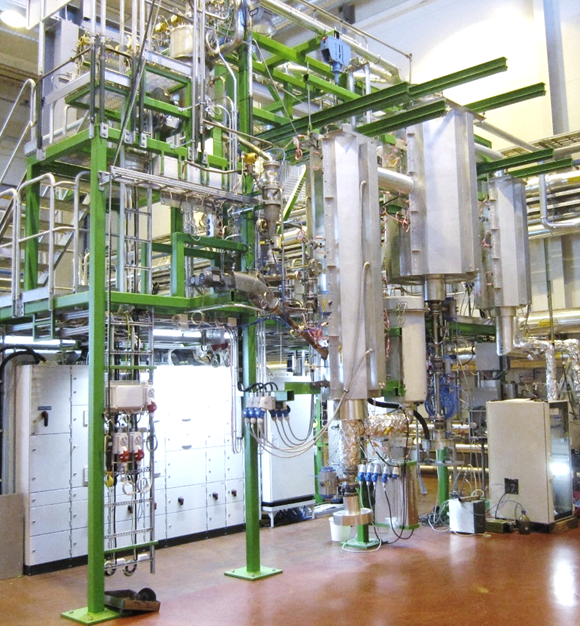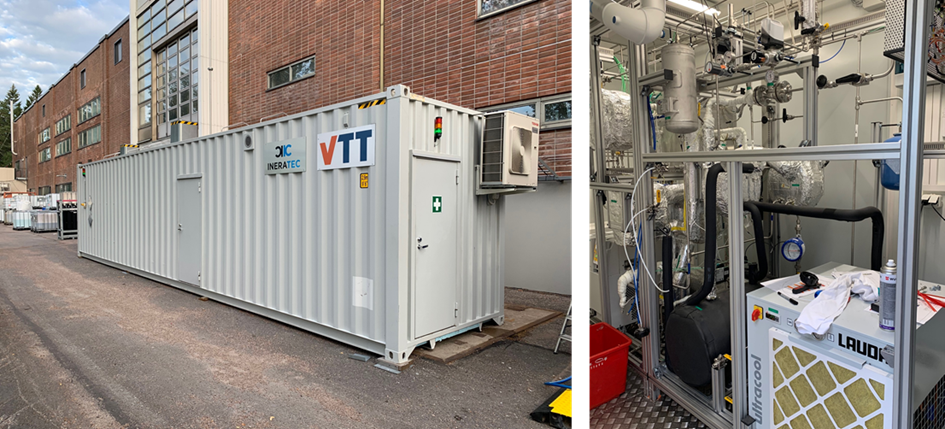Intermediate result from partners VTT, INERATEC, NESTE, CSIC
Result has been achieved on 12 Jun 2020 in month 21 of the project.
One of the core activities in the project is the pilot-scale validation of the entire process chain from biomass gasification up to hydroformylation of the C5-C10 hydrocarbon fraction. The front-end process chain comprising of the gasification, gas clean-up and Fischer-Tropsch (FT) synthesis steps was assembled at VTT at end of March 2020, and the newly developed cobalt-based Fischer-Tropsch catalyst by CSIC was loaded into INERATEC’s microstructured FT reactor. Despite the challenges set by COVID-19, the pilot experiments could be executed on schedule; altogether five week-long test runs were carried out at VTT’s Piloting Centre Bioruukki in Espoo (Finland) in April-June 2020 using bark and wood pellets as feedstock. The Fischer-Tropsch oil and wax were recovered downstream the synthesis reactor by condensation and sent to distillation to NESTE. Following distillation, the C5-C10 hydrocarbon cut was further shipped to partner MPI for hydroformylation experiments.
- Objective: Validate the performance of the gasification, gas clean-up and Fischer-Tropsch synthesis units in week-long experiments and produce biomass-derived Fischer-Tropsch syncrude for hydroformylation experiments.
- Research: Validation test campaigns where the steam-blown gasification process was coupled with Ineratec’s FT synthesis unit employing the novel cobalt-based FT catalyst developed by CSIC.
- Results:
- As a result of successful REDIFUEL pilot test campaigns, the front-end gasification concept from biomass gasification up to final gas clean-up was found technically feasible for converting lignocellulosic feedstocks into synthesis-quality gas. For example, no signs of FT catalyst deactivation could be detected during testing, indicating that syngas impurities that are considered as FT catalysts poisons (e.g. H2S) were removed to an acceptable level in the gas clean-up train (typically well below 0.1 ppm).
- The cobalt-based Fischer-Tropsch catalyst developed by CSIC could indeed produce the unconventional FT product pattern with a high share of α-olefins in the hydrocarbon mixture, as targeted in REDIFUEL. The share of C5-C10 olefins in the C5-C10 hydrocarbon fraction was roughly 30 wt-% (oil fraction). Howeover, the relatively low productivity of the selected FT catalyst led to further development activities to find a better compromise between selectivity to olefins and overall activity of the catalyst. Lab-scale studies had already shown that catalysts that were more selective to the said olefin fraction were less active per unit mass/volume and vice versa.
- What will it be used for: The results concerning the performance of the gasification, gas cleaning and Fischer-Tropsch synthesis units will be used to design the overall REDIFUEL process and estimate the costs (CAPEX/OPEX) of the commercial reference plant in the scale of 20-50 MW biomass input. The C5-C10 hydrocarbon fraction (enriched in alpha-olefins) retrieved from the pilot experiments will be used for studying the catalyst stability in hydroformylation.
- Impact: The validation experiments were a crucial step in demonstrating the technical viability of the REDIFUEL concept that combines biomass gasification with Fischer-Trospch synthesis and hydroformylation.

Figure 1: VTT’s gasification test facility that was used in REDIFUEL experiments

Figure 2: VTT’s Mobile Synthesis Unit (MOBSU) that incorporates Ineratec’s microstructured FT reactor





